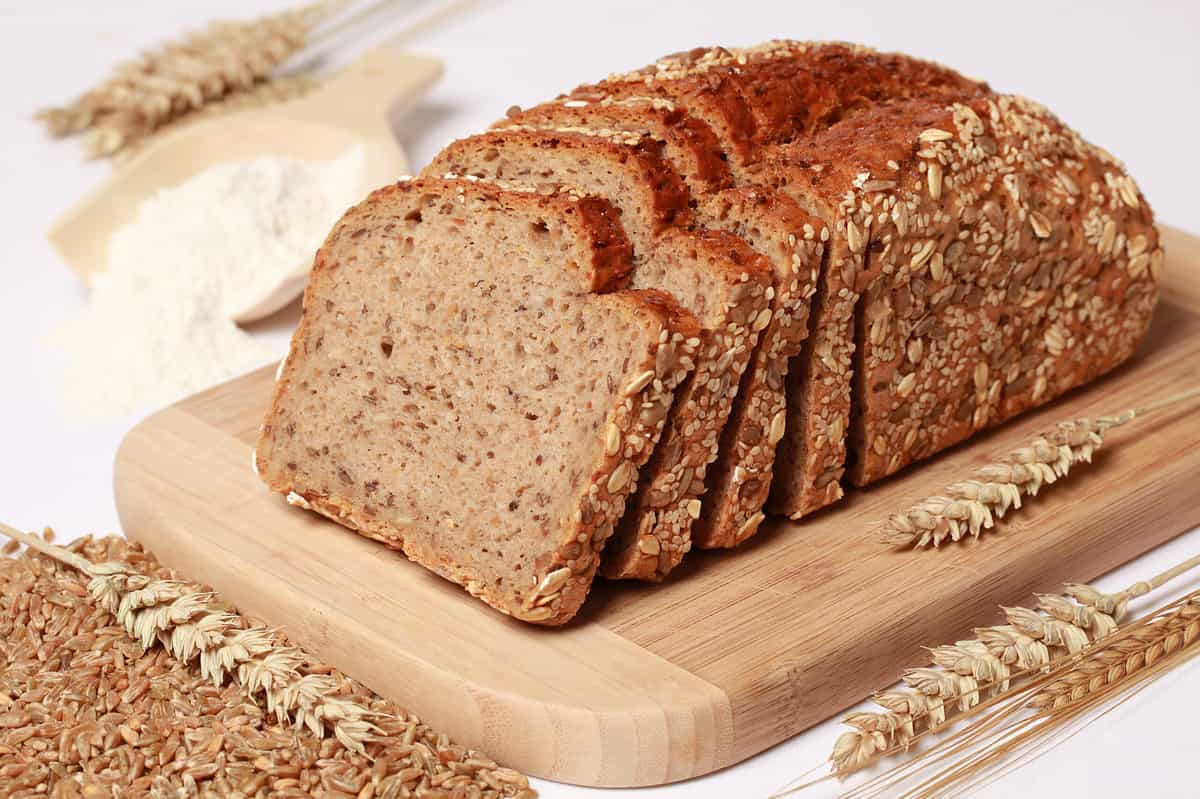Wheat bread might just be one of the sandwich’s greatest allies. A healthier choice than white bread, given that it typically offers more fiber and fewer calories, it’s a frequent go-to — whether it’s on either side of ham and cheese, peanut butter and jelly, or something more exotic. But is wheat bread healthy? That answer largely depends on whether or not it’s 100% whole wheat bread. If not, it can contain enriched flour, which offers no nutritional value and can overwhelm your system with sugar, causing it to crash. Let’s take a closer look at the science behind the health advantages and disadvantages of wheat bread.

Wheat bread is a go-to for sandwiches, avocado toast, and more. But is wheat bread healthy? We're taking a closer look.
©Tamakhin Mykhailo/Shutterstock.com
What is Wheat Bread, and How is it Made?
In a nutshell, whole wheat (or wholemeal) bread is made from 100% whole wheat flour, which is comprised of wheat berries that have been milled or ground down. The bread contains all parts of the wheat grain kernel. Additionally, a whole wheat loaf is often topped with wheat grains, be it whole or cracked.
Wheat Bread vs. White Bread: What are the Similarities and Differences?
Wheat bread is most often compared to white bread, given that they are two of the most popular breads used for sandwiches. Of course, they also support many other culinary uses, such as being used to crust chicken or fish and stuffing peppers or mushrooms. But there’s been a lot of discussion surrounding how they compare to one another when it comes to nutritional value. Aside from the more obvious aesthetic differences, such as a darker crust, whole wheat bread tends to be denser in texture and has a stronger taste and smell than white bread. It also typically possesses a shorter shelf life.
From a nutritional standpoint, whole wheat bread has more fiber than white bread. Given that it endures less processing, it also retains a higher number of vitamins and nutrients. Surprisingly, the carbohydrate content of white bread and wheat bread is similar or equivalent, but wheat bread generally possesses fewer calories.

Wheat bread offers a wonderful foundation for healthy breakfast options such as this avocado toast with micro greens and a poached egg.
©artem evdokimov/Shutterstock.com
What are the Health Advantages and Disadvantages of Wheat Bread?
First things first, our bodies need carbohydrates to function. Without them, we can experience side effects such as sluggishness, lack of mental clarity, and low energy. That’s where wheat bread comes in, offering a way to boost your energy, keep your blood cholesterol levels in check, and even aid in digestion, thanks to its fiber content. Studies also show that whole grains “offer a complete package of health benefits, unlike refined grains, which are stripped of valuable nutrients in the refining process.”
An Iowa Women's Health Study found that eating whole grains is linked to a reduced risk of inflammation and infectious diseases (not including cardiovascular and cancer causes), such as Crohn's disease, asthma, and rheumatoid arthritis. In yet another study, a whole-grain diet was found to reduce the risk of cardiovascular issues in adults struggling with obesity. Additionally, it's important to note that wheat breads have less of a negative impact on your body's blood sugar level, which can be healthier for those with insulin resistance.
Of course, as with anything, paying close attention to ingredients is an important way to distinguish between a wheat bread that falls on the healthier end of the spectrum versus one that doesn't. To ensure you receive the maximum health benefits, look for brands that say 100% whole wheat and have whole wheat flour listed as the first ingredient. If this isn't the case, your wheat bread may contain enriched flour, which has zero nutritional value and runs the risk of overwhelming your system with sugar.

Whole wheat bread is typically darker and denser than white bread. It is also often coated with whole grains.
©Markus Mainka/Shutterstock.com
Important Takeaways
- Whole wheat bread is typically darker and denser than white bread. It is also often coated with whole grains.
- Whether or not wheat bread is healthy largely depends on whether or not it’s 100% whole wheat bread.
- To ensure you receive the maximum health benefits, look for brands that say 100% whole wheat and have whole wheat flour listed as the first ingredient.
- Whole wheat bread can boost your energy, keep your blood cholesterol levels in check, and aid in digestion, thanks to its fiber content.
- Eating whole grains has been linked to a reduced risk of inflammation, infectious diseases, and cardiovascular issues in adults struggling with obesity. It can also be healthier for those with insulin resistance thanks to its lower sugar content.
Up Next:
- Barley vs. Wheat: 3 Key Differences & a Full Health Comparison
- Whole Grain vs Whole Wheat: Which is Healthier & Key Differences
- Salted vs. Unsalted Butter: When Should You Use Each?
The image featured at the top of this post is ©Tamakhin Mykhailo/Shutterstock.com